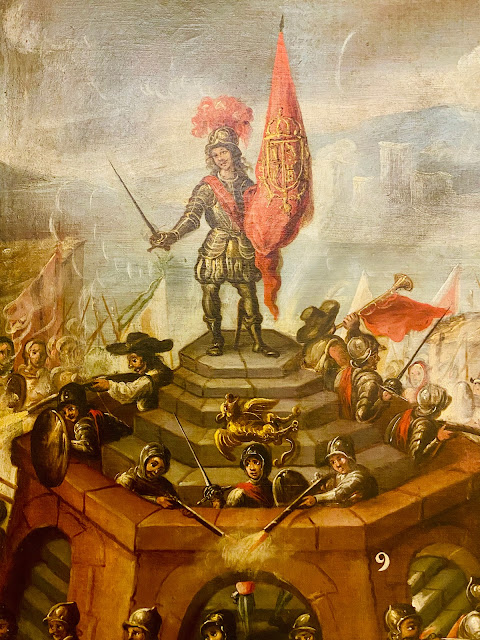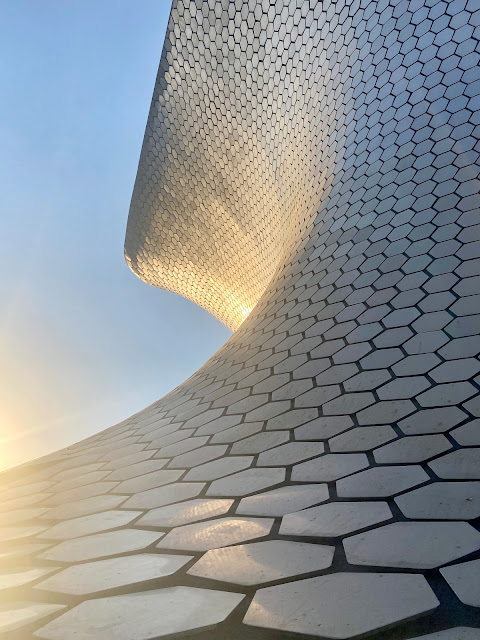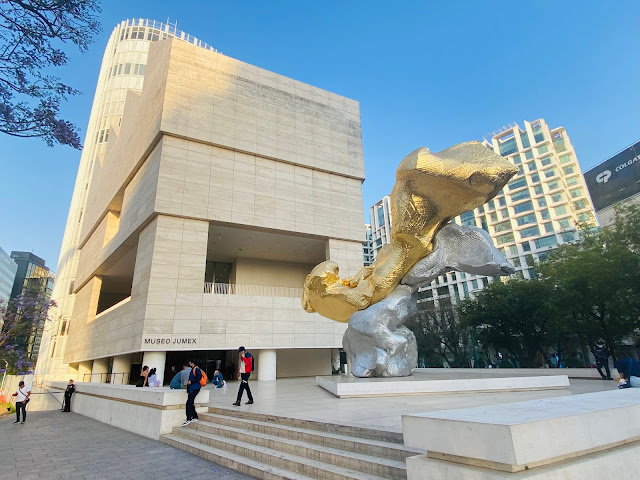Carlos Slim, the wealthiest man in Latin America and one of the ten richest people in the world, built the Soumaya Museum, named after his late wife.
A Rodin sculpture greets visitors. I often adopt the same pose when reading the New York Times. Slim owns more shares in the company than anyone else. No wonder we rushed to see his museum the night we arrived in Mexico City. Free admission and a late closing helped.
It's hard not to think of the Guggenheim Bilbao when you see the building from the outside and inside, the curved ramp that takes you from floor to floor reminds you New York's original.
 |
| "Tebas sentada en una silla poltrona" by Giacomo Manzù (1987) |
You can't miss the last mural attributed to Diego Rivera, installed near the museum's entrance.
Chris and I began with the terrific collection of Mexican art on the top floor, including this screen that maps Mexico City as it looked centuries ago, before Hernán Cortés colonized New Spain in the early 16th century and Catholicized its indigenous population of Mesoamericans.
 |
| Detail from"La Conquista de México" |
 |
| "Peón" by Alfredo Ramos Martínez (1938) |
 |
| "Milagro del Tepeyac" by Jorge González Camarena (ca 1947) |
 |
| Detail from Retablitos del Camino Tierra Adentro (ca 1830-60) |
Chris noted an interesting parallel between Mexican Catholicism's obsession with hearts and the blood sacrifices made during the pre-Christian era.
 |
| Alegoría del Sagrado Corazón de Jesús by Miguel de Herrera (1747) |
I didn't have to look any further than a huge cabinet full of bizarre works that allegorize the hearts of Jesus and Mary, created from 1730 to 1810, for macabre evidence in support of his observation. Call it Mexican Horror Story.
The Soumaya collection is an excellent primer for beginning to understand how Mexican artists have depicted their nation's complex and often deadly history in spite of the fact that few of the label texts are translated into English, a handicap we encountered in nearly every other museum we visited. At least one of the artists whose work is exhibited crossed the line into violence himself. David Alfaro Siqueiros, a committed Stalinist who painted this homoerotic mural in 1959, tried to assassinate Leon Trotsky 20 years earlier!
 |
| "La tierra como el agua, la industria nos pertenece" (detail) |
But some of the works are simply beautiful, if a little campy. Not that there's anything wrong with that!
 |
| "México lindo" by José Bribiesca Ruvalcaba (ca 1953) |
 |
| "Flor del Bajío" by Eduardo Cataño Wilhelmy (ca 1962-63) |
On the other hand, the Soumaya's extensive collection of European art suffers from what I call the Crystal Bridges problem: enormous acquisition budgets can name check great artists (Raphael, Brueghel, Van Gogh, Renoir, and DeKooning in this case, among many others) but great collections aren't built with second-rate works. That said I did enjoy some of them. Hello, Dali. And again!
 |
| "Unicornio" by Salvador Dali (1984) |
 |
| "Los brazos de Dalí by Salvador (1965) |
 |
| "Composición en el taller" by Tamara de Lempicka (1941) |
 |
| Detail from "Doña María Ignacia de Azlor y Echeverz" (Anonymous, ca 1730-1732) |
And any new museum (the Soumaya opened in 2011) with astute curation has a much easier opportunity to establish a good modern art collection.
 |
| "Cabeza de Laocoonte" by Robot City-Italian Art Factory (2022) |
As our visit wound down (literally), people had begun to arrive for a special event in the main hall where some classical variation of Led Zeppelin's "Kashmir" pounded through the speakers. There's David again. He's ubiquitous in Mexico City. He can also be found in Louisville, of all places!
The catering staff looked bored.
Before heading back to Roma, I ran across the street to take a picture of Museo Jumex. Its architect, David Chipperfield, just won the Pritzker Prize but we didn't have time to go inside. Next time!











No comments:
Post a Comment